
The Whole30 Diet, its benefits, guidelines, and restrictions
Apr 07, 2025
What to Do (Allowed Foods):

What Not to Do (Avoid Completely):
Benefits:
After Whole30 (Reintroduction Phase):
Why Would Somone Do Whole 30?
A person might choose to do the Whole30 diet for several reasons—most of which revolve around resetting their body and mind around food. Here are the most common motivations:
1. Identify Food Sensitivities

Whole30 helps eliminate common trigger foods (like dairy, gluten, sugar, and soy). After reintroducing them one by one, people can better understand how those foods affect their digestion, mood, skin, energy, or pain levels.
2. Break Unhealthy Eating Habits

It’s great for people who:
- Emotionally eat or binge
- Constantly crave sugar or carbs
- Struggle with snacking out of boredom
Whole30 creates strict boundaries to help reset behavior and build awareness.
3. Improve Gut Health & Digestion

Many report less bloating, heartburn, or irregularity after cutting out inflammatory foods like processed grains, dairy, and legumes.
4. Increase Energy & Mental Clarity

By eating real, nutrient-dense foods consistently, many people notice fewer energy crashes, better focus, and more sustained energy throughout the day.
5. Reduce Inflammation & Pain

Chronic inflammation from poor diet can lead to joint pain, headaches, fatigue, etc. Whole30’s clean eating approach often helps reduce these symptoms.
6. Improve Skin Conditions

Some people see improvements in acne, eczema, or other skin issues, which can be linked to food intolerances or sugar overload.
7. Create a Healthier Relationship with Food

Whole30 isn’t about weight loss—there’s no calorie counting or weighing yourself. It’s about reconnecting with hunger cues, understanding emotional eating, and finding balance.
Who Might Benefit Most:
- Individuals looking for a non-scale-based health reboot
- People who suspect food allergies or intolerances
- Those wanting to “reset” after a period of poor eating
- Anyone struggling with sugar addiction or cravings
- People with autoimmune or digestive issues
Don't miss a beat!
New moves, motivation, and classes delivered to your inbox.
We hate SPAM. We will never sell your information, for any reason.
